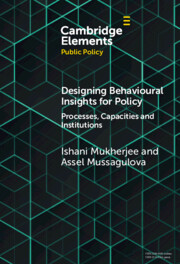Refine search
Actions for selected content:
39 results
4 - Regulatory Design, Trust, and Voluntary Compliance
-
- Book:
- Can the Public be Trusted?
- Published online:
- 11 October 2025
- Print publication:
- 30 October 2025, pp 92-120
-
- Chapter
-
- You have access
- Open access
- HTML
- Export citation
Behavioural insights policies in Canada: support for nudges vs nudging
-
- Journal:
- Behavioural Public Policy , First View
- Published online by Cambridge University Press:
- 17 September 2025, pp. 1-19
-
- Article
-
- You have access
- Open access
- HTML
- Export citation
Hide the Cookie Jar: Nudging toward healthy Eating
-
- Journal:
- Journal of the Economic Science Association / Volume 11 / Issue 1 / January 2025
- Published online by Cambridge University Press:
- 05 August 2025, pp. 106-116
-
- Article
-
- You have access
- Open access
- HTML
- Export citation
Nudges, preferences and competences: a critique of both neoclassical and behavioral economics
-
- Journal:
- Behavioural Public Policy / Volume 9 / Issue 3 / July 2025
- Published online by Cambridge University Press:
- 06 May 2025, pp. 545-559
-
- Article
-
- You have access
- Open access
- HTML
- Export citation
The impact of taxation and signposting on diet: an online field study with breakfast cereals and soft drinks
-
- Journal:
- Experimental Economics / Volume 24 / Issue 4 / December 2021
- Published online by Cambridge University Press:
- 14 March 2025, pp. 1294-1324
-
- Article
- Export citation
7 - Market-based Economic Instruments
-
- Book:
- An Introduction to Energy Economics and Policy
- Published online:
- 19 December 2024
- Print publication:
- 19 December 2024, pp 162-202
-
- Chapter
-
- You have access
- Open access
- Export citation
Behavioral strategies for reducing corruption: from regulation to choice architecture
-
- Journal:
- Behavioural Public Policy , First View
- Published online by Cambridge University Press:
- 15 November 2024, pp. 1-18
-
- Article
-
- You have access
- Open access
- HTML
- Export citation
Shoves, nudges and combating misinformation: evidence on a new approach
-
- Journal:
- Behavioural Public Policy , First View
- Published online by Cambridge University Press:
- 31 October 2024, pp. 1-17
-
- Article
-
- You have access
- Open access
- HTML
- Export citation
10 - Techniques of Regulatory Intervention
- from Part III - The Police Power’s Promise
-
- Book:
- Good Governing
- Published online:
- 23 October 2024
- Print publication:
- 17 October 2024, pp 318-330
-
- Chapter
-
- You have access
- Open access
- HTML
- Export citation
The economics of cognitive institutions: mapping debates, looking ahead
-
- Journal:
- Journal of Institutional Economics / Volume 20 / 2024
- Published online by Cambridge University Press:
- 13 September 2024, e28
-
- Article
- Export citation
The effectiveness of a green default nudge in achieving resource conservation
-
- Journal:
- Agricultural and Resource Economics Review / Volume 53 / Issue 2 / August 2024
- Published online by Cambridge University Press:
- 21 May 2024, pp. 337-355
-
- Article
-
- You have access
- Open access
- HTML
- Export citation
8 - Do the Public Support ‘Hard’ or ‘Soft’ Public Policies?
- from Part I - Evidence from Experiments and Behavioural Insights
-
-
- Book:
- Behavioural Economics and Policy for Pandemics
- Published online:
- 31 January 2025
- Print publication:
- 02 May 2024, pp 126-147
-
- Chapter
- Export citation
9 - One Size Does Not Fit All
- from Part I - Evidence from Experiments and Behavioural Insights
-
-
- Book:
- Behavioural Economics and Policy for Pandemics
- Published online:
- 31 January 2025
- Print publication:
- 02 May 2024, pp 148-190
-
- Chapter
- Export citation

Designing Behavioural Insights for Policy
- Processes, Capacities & Institutions
-
- Published online:
- 24 April 2024
- Print publication:
- 16 May 2024
-
- Element
- Export citation
3 - From the “Reconciliation Problem” to an Individuality Reconstruction Problem
- from Part I - The Failed Pathway and Exit Strategies
-
- Book:
- Identity, Capabilities, and Changing Economics
- Published online:
- 11 January 2024
- Print publication:
- 01 February 2024, pp 53-78
-
- Chapter
- Export citation
3 - How We Make Decisions
-
- Book:
- Decisions for Sustainability
- Published online:
- 25 May 2023
- Print publication:
- 08 June 2023, pp 37-58
-
- Chapter
- Export citation
10 - Behavioural Health Insurance Uptake
-
- Book:
- Behavioural Incentive Design for Health Policy
- Published online:
- 18 May 2023
- Print publication:
- 01 June 2023, pp 139-148
-
- Chapter
- Export citation
2 - Advice
- from Part I - Background
-
- Book:
- Advice, Social Learning and the Evolution of Conventions
- Published online:
- 09 March 2023
- Print publication:
- 09 March 2023, pp 21-44
-
- Chapter
- Export citation
2 - Other Voices
-
- Book:
- A Political Economy of Behavioural Public Policy
- Published online:
- 16 February 2023
- Print publication:
- 23 February 2023, pp 26-40
-
- Chapter
- Export citation
Improving acceptability of nudges: Learning from attitudes towards opt-in and opt-out policies
-
- Journal:
- Judgment and Decision Making / Volume 14 / Issue 1 / January 2019
- Published online by Cambridge University Press:
- 01 January 2023, pp. 26-39
-
- Article
-
- You have access
- Open access
- HTML
- Export citation
